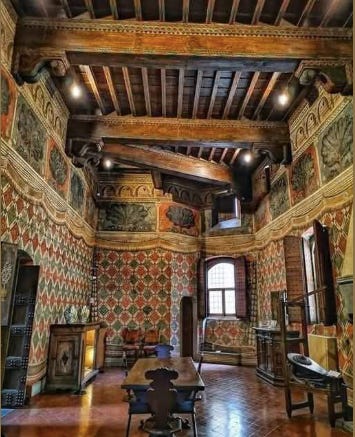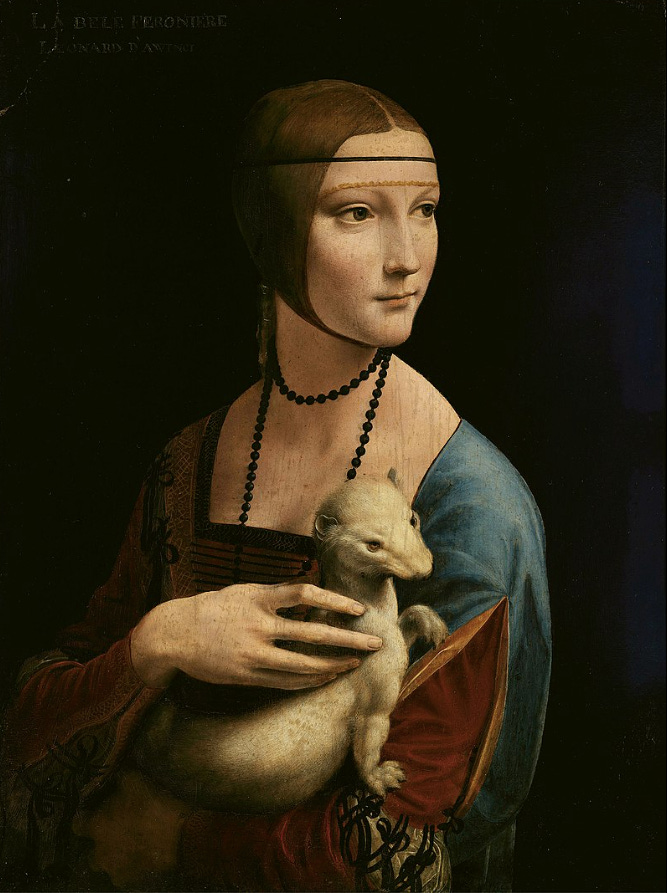The Palazzo Davenzati, Florence
Interesting how much that diagonal beams in the back of the room sets the space in motion. This might be a setting the Mona Lisa was familiar with. The Mona Lisa, who Vasari praised because Leonardo had captured an everyday Florentine house wife, and due to some serious PR in the nineteenth century became the incredible mysterious beauty causing so much trouble at the Louvre that the staff went on a wildcat strike, tired of being trampled by the 20,000 who squash into the gallery to hold up their phone and get a picture of people in front of them holding up their phones.
About 8.7 million travelers visited the Musée du Louvre in 2024, according to a museum press release.
The woman at the center of the chaos is Leonardo da Vinci’s "Mona Lisa," situated in the Louvre’s largest room, the Salle des États.
The "Mona Lisa" by Leonardo da Vinci attracts roughly 20,000 visitors per day. Some of the floors in the Louvre look like the floor in a barn, worn down to bare wood. Some of the painting appear more obscure than in their well lit illustrations in art books. In January, French President Emmanuel Macron announced a plan to move the 16th-century painting into its own wing amid overcrowding.
Not bad for a subject sporting eyebrow treatment, the latest style, not seen again until the movie Gummo in 1997. During the Renaissance women often plucked or even shaved their eyebrows to achieve a higher forehead, which was considered a sign of beauty.
More strikingly, there is evidence that some women used mouse fur to create false eyebrows that were then glued on. A high forehead was the ideal, some shaved their hairline back. Mouse skin eyebrows were ripe for satire in the Eighteenth century but were serious business before that.
When Italian handyman Vincenzo Peruggia stole the Mona Lisa in 1911 it set off a worldwide media frenzy that went on for two years until he was caught trying to sell it in Florence, making the painting the most recognized and most hyped in the world. Now no longer a Florentine Housewife, Vasari’s words, but a great beauty with a smile so mysterious "no man could fathom its depth"
Then artists and even Sigmund Freud pilled on: " Romantics like Gautier and Pater and Symbolists like Laforgue discovered and rediscovered the notorious “enigmatic” smile and interpreted the Gioconda as a femme fatale, a fascinating woman with sinister powers. Gautier in 1858 described the magic charm of Mona Lisa whose “expression attracts you irresistibly . . . while the serpentine mouth . . . mocks you . . .” On looking at the painting you are driven to despair, and “you discover that your melancholy arises from the fact that La Joconde 300 years ago greeted your avowal of love with this same mocking smile . . . here simple fidelity to nature has completely disappeared; the eternal feminine has taken its place."
“CRITICISM OF THE MONA LISA over the past 4 1/2 centuries has been both voluminous and varied, but no phase of the long history of these opinions is more unusual than the period extending from the mid-19th century to the early 20th century, and climaxing in the works of Freud and Duchamp with which this paper is mainly concerned. During this period critics most often indulged themselves in anecdotes either about the personality and expression of Mona Lisa, or about Leonardo’s relation to his model. Romantics like Gautier and Pater and Symbolists like Laforgue discovered and rediscovered the notorious “enigmatic” smile and interpreted the Gioconda as a femme fatale, a fascinating woman with sinister powers. Gautier in 1858 described the magic charm of Mona Lisa whose “expression attracts you irresistibly . . . while the serpentine mouth . . . mocks you . . .” On looking at the painting you are driven to despair, and “you discover that your melancholy arises from the fact that La Joconde 300 years ago greeted your avowal of love with this same mocking smile . . . here simple fidelity to nature has completely disappeared; the eternal feminine has taken its place.”
Pater, in 1869, building on Gautier’s ideas, soared to even greater heights of rhetoric in his famous passage on Lady Lisa, who is “older than the rocks among which she sits; like the vampire, she has been dead many times, and learned the secrets of the grave; and has been a diver in deep seas . . . and, as Leda, was the mother of Helen of Troy, and, as St. Anne, the mother of Mary . . .”
At the time, the outstanding feature was that the painting was of an ordinary citizen, something new at the time, indeed . Duke Ludovico “Il Moro” Sforza asked Leonardo to paint two of his mistresses, Cecilia Gallerani and Lucrezia Crivelli. "It is because of this fortunate happenstance that Leonardo directed his prodigious talent to the problem of secular portraiture." "the idea of having one’s portrait painted simply because one could afford it, was a relative novelty.
The Quattrocento Renaissance accelerated the spread of the genre, but demanded that portrait artists—like their brethren in architecture and sculpture—follow the example of classical models. The only form of ancient portraiture still extant, however, was Roman coins. Thus, the portrait en profil became the preferred style among the upper classes because of its obvious classicizing tenor."
That hand
“If the poet says that he can inflame men with love..the painter has the power to do the same…in that he can place in front of the lover the true likeness of one who is beloved, often making him kiss and speak to it.” Leonardo DaVinci
When DaVince's Lady with an Ermine was in SF I went on the first day and was enthralled by the painting which was under very thick clear glass that was touted to be non reflective but gave the feeling of seeing the painting through an aquarium with only a faint reflection of your face staring wide eyed.
It’s one of those painting that gives the sensation of your visual acuity improving just by looking at it.
Favorite part of the story of the painting was when the Luftwaffe was bombing the town, people rushed to the castle and grabbed the painting and put it in a wagon to save it. Was trying to imagine what people would rush to save here.
I kept seeing faintly familiar faces but I haven't gotten the local paper or watched local television in ten years or more. So it took a while to get that all those faces that I couldn’t quite recognize were press, I had come on press day. The newspaper printed the wrong date. I wondered why there wasn’t the usual crush. It was great to be able to move around and not be jostling in a crowd all trying to see past one another’s heads. Lent an uncanny valley air I can still feel.
"It is in this milieu that Leonardo forged his first major breakthrough in secular portraiture with his portrait of the Lady with an Ermine. The revolutionary features of this picture—its soft chiaroscuro; the sharp contrast between living flesh and the dark limbo of the background; and the attentive gaze of the sitter, as if caught by something outside our view—have been imitated in portraiture and modern photography so many times that it is difficult for us to grasp the painting’s originality." [monalisa.org]
1911 was in the fading days of yellow journalism, now revived by the Fairness Act being repealed and giving us Fox News and now Deep Fake copies of leading figures in the arts entertainment and government, with figures in government trying to out Deep Fake Deep Fake. Last night I heard an anchorman say that bombing Iran was a deescalation not an escalation because things were worse before and now they are better. As for the Mona Lisa, it is sobering to see the falderal heaped on the painting having the power to close the Louvre over a hundred years later.
sources: [https://monalisa.org/2013/10/26/the-earlier-version-of-the-mona-lisa-as-the-portrait-of-lisa-del-giocondo-described-by-vasari/]
[https://www.artforum.com/features/freud-and-duchamp-the-mona-lisa-exposed-211110/]
Published 1982
William Burroughs on Flooding the Zone with Shit, a template for the Steve Bannons of the world....
For a start you scramble the news all together and spit it out every which way on ham radio and street recorders. You construct fake news broadcasts on video camera. . . .And you scramble your fabricated news in with actual news broadcasts.
You have an advantage which your opposing player does not have. He must conceal his manipulations. You are under no such necessity. In fact you can advertise the fact that you are writing news in advance and trying to make it happen by techniques which anybody can use.
And that makes you NEWS. And a TV personality as well, if you play it right. You want the widest possible circulation for your cutup video tapes. Cutup techniques could swamp the mass media with total illusion.
The simplest experiment consists in playing back a scrambled message to subject. Message could contain simple commands. Does the scrambled message have any command value comparable to post-hypnotic suggestion? Is the actual content of the message received?
Let us say the message is fear. For this we take all the past fear shots of the subject we can collect or evoke. We cut these in with fear words and pictures, with threats, etc. This is all acted out and would be upsetting enough in any case. Now let’s try it scrambled and see if we get an even stronger effect.
I have frequently spoken of word and image as viruses or as acting as viruses, and this is not an allegorical comparison. It will be seen that the falsifications in syllabic Western languages are in point of fact actual virus mechanisms.”For a start you scramble the news all together and spit it out every which way on ham radio and street recorders. You construct fake news broadcasts on video camera. . . .And you scramble your fabricated news in with actual news broadcasts.
The Revised Boy Scout Manual [William S Burroughs/Ohio State Press]
Burroughs used Bill Lee as his pen name for Junkie. His uncle Ivy Lee was the founder of public relations as we know it today. He also advised the German government in the early days of the Nazi Party. Ivy Lee " was retained by John D. Rockefeller Jr to represent his family and Standard Oil ("to burnish the family image"), after their bloody repression of the coal mining strike in Colorado known as the "Ludlow Massacre." Lee warned that the Rockefellers were losing public support due to ordering the massacre of striking workers and their families (and the burning of their homes). He developed a strategy that Junior followed to repair it. It was necessary for Junior to overcome his shyness, go personally to Colorado to meet with the miners and their families, inspect the conditions of the homes and the factories, attend social events and listen to the grievances (all the while being photographed for press releases)."









